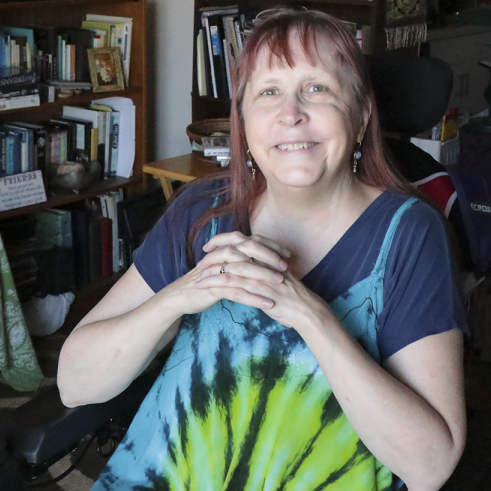A Rolling Perspective: Get The Popcorn!

“Get the Popcorn, my Life is on!” My catchphrase, found in Byron Katie’s A Thousand Names for Joy, captures the marvel and wonder of watching everything I could possibly want or need manifest itself before my eyes. It entertains me more than any movie I could watch (even if I could afford it). The funny thing is, I don’t even like popcorn. It reminds me too much of the obsessive calorie counting I engaged in (fruitlessly) for years. These days, I eat what I love and love what I eat, and I’m at my ideal weight. Imagine that.
I want you to enjoy life as much as I do, so I’m going to share my “Get the Popcorn” scheme. It’s a great follow up to last month’s “Running on Empty.” If you haven’t read the March article, would you take a moment and do it now?
People think I’m special, and I’m so not. I might present things in an engaging way, but the experiences themselves are available to you, too. IT’S EASY. Whatever you think is missing in your life—happiness, health, love, financial security—you already have it. You just need to change your perspective.
You’ve heard it’s better to teach hungry people to fish instead of just giving them fish. Get the Popcorn steps beyond that: you’ll already know how to fish if that’s what’s important to you. I went vegan, so fish isn’t even on my menu. But finding excellent vegetables and tasty alternative protein sources are, so I was motivated to learn a LOT about where and how to get them as a disabled person with no car, using food stamps only.
How do you discover your priorities? First, look around you. What three items take pride of place in your space? (My home is full of books, communications materials and devices, and foodie stuff.) Second, what do you love to talk about? And third, what does no one everhave to remind you to do? This simple noticing exercise will reveal what you value most.
You’re nearly ready for Get the Popcorn when you’ve noticed what your environment says about you. You’re really ready if you’ve saved all your receipts, talked to your doctor about food, wrote the date on bottles you opened, and found out if you’re entitled to food stamps (or more food stamps*).
Here are the steps to the first and most important part of the Get the Popcorn scheme:
Go through the receipts, one by one
Add up all your sources of income, no matter how small
List your fixed expenses
Subtract this number from the TDI
Calculate what percent of your budget you spend on the rest—especially the “GPs”
Example: If my TDI is $30 and I’m spending $10 a day on cupcakes, it’s 10 ÷ 30 = .33, or 33%. (And time to buy fewer cupcakes. Notice that I didn’t say “don’t buy any.” You can honor your priorities without making every day Cupcake Appreciation Day.)
Wait till you see how valuable this budget awareness exercise is. It not only highlights what you value most, but the new awareness will supercharge your brain. It will come up with better and cheaper ways to meet your priorities. You’ll notice your spending patterns change—effortlessly. You’ll be attracted to places that have sales on things you buy regularly as if by a magnet. New ways to save or earn money appear as if by magic. You’ll stop craving certain foods, and you’ll find you leave stores without even glancing at point-of-sale items.
This switch from diet- and budget-destroying habits to better financial and physical health is pretty trippy, unless you understand that (1) our brains register and remember far more details than we realize, and (2) humans are hardwired to find ways to fulfill their highest values. We short-circuit our higher brain when we reach for quick fixes, whether of the dopamine-producing variety, or the words of “experts” whose highest priorities are not (because they cannot be) ours.
When you are clear about your priorities, Mind will instantly generate a host of ideas for you to achieve them, whether it’s balancing your budget, opening your own business, or finding Mr. or Ms. Right. You’ll suddenly realize that the help that’s out there—food stamps, free clinics, reduced fares, assistive devices, subsidized housing—doesn’t diminish your independence, it fosters it. To use these services demonstrates not weakness, but strength. You’re showing up for yourself and honoring your highest priorities.
Then all you have to do is (mentally) sit back, get your bucket of popcorn (if that’s your thing), and watch the best movie you’ll ever see: your own Life.
*Clarification: Last month we mentioned that seniors and disabled persons are entitled to credit for their out-of-pocket medical expenses, including over-the-counter medications (if doctor-prescribed) and assistive devices (no prescription required if you’re on SSDI). Please note that anyone who qualifies for food stamps is entitled to submit their receipts to their local electronic benefits transfer authority. Copies of the receipts can be faxed, emailed, snail-mailed, or submitted in person. Keep your originals.
For example, my doctor prescribes B12 and D3. It’s cheaper to buy it over the counter, so I take a picture of my receipts and email them for an increase to my EBT. If a doctor prescribes things for your child (cough syrup, Tylenol, vitamins) and you’re receiving EBT, you can submit receipts for those expenses. I received an increase for buying such things as a wheelchair ramp, a Rollator-type walker, and a cane. If you’re paying a Medicare and/or Medicaid premium, these count as well. Time restrictions apply, so get those receipts together now! You can contact Jewish Family Services and find out exactly what you are entitled to and how to submit them. [Bonus: Your receipts may also entitle you to lower rent if you’re in subsidized housing.]
Jennifer Holland taught herself to read and write at age four and has been doing both ever since. Minnesota-born and Wisconsin-bred, she nonetheless inherited the Irish perchant for travel. Despite the shoestring budget, she visited a dozen countries before her diff-ablement, and even lived in Ireland for nearly fifteen years. Her encounters with other cultures inform the quirky insights into human behavior that find their expression in her poetry, novels, and non-fiction works. When she's not reading or writing, she enjoys chair yoga, video chats with her children and gradchildren, and living happily with MS on a tiny fixed income.


